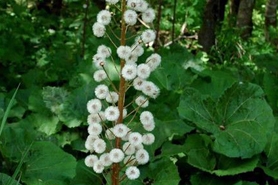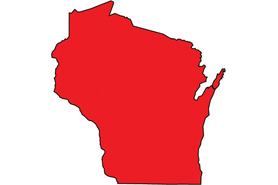Butterfly dock
(Petasites hybridus)
Herbaceous perennial resembling rhubarb favors moist to wet areas. The flowering stalk, composed of bundles of tiny radial flowers, emerges from underground in spring before the large heart-shaped leaves fully expand.
Other names for this plant include:
- Common names: butterbur, bog rhubarb, devil’s hat, winter heliotrope, purple butter-bur, pestilence wort, colt's foot
- Scientific names: Petasites officinalis, Petasites vulgaris, Petasites ovatus, Tussilago hybrida
Classification in Wisconsin: Prohibited
- Ecological Threat
-
- Invades wetlands, forests, forest edges, bogs, marshes, and other semi-shaded moist areas.
- Huge leaves, spanning 100 cm across, shade out native species.
- Aggressive growth quickly crowds out desired species.
- Plants readily reproduce by root fragmentation and creeping rhizomes.
- This species is cultivated for its medicinal properties.
- Identification
-
Leaves & stems: Large, heart-shaped leaves and thick fleshy stalks, span up to 1 meter across. Plants resemble rhubarb. Leaves do not fully emerge until after flowering has occurred.
Flowers: Pinkish flower stalks, composed of bundles of tiny pink radial flowers, emerge from underground in early spring. Blooming occurs before the leaves fully emerge and expand. Male and female flowers typically appear on different spikes.
Fruits & seeds: Seeds are attached to feathery pappus (plumes of fine white bristles). In some conditions, seeds are sterile.
Roots: Tuberous base with extensive, fleshy creeping rhizomes. Rhizomes are blackish on the outside with white interiors.
Similar species: Butterfly dock may resemble other members of Petasites genus, but the leaves are unmistakably larger.
- Control
- Mechanical:
- Due to the plants spreading rhizomes, dig or hand pull the entire plant's root system. Monitor for re-sprouts.
- The possibility of accidental spreading is high due to the plant's ability to reproduce via root fragments.
- Dispose of plant debris in trash bags.
- Apply herbicides during the active growing season.
- Glyphosate or Metsulfuron can be used as a foliar spray, painted directly onto large leaves or as a spot treatment.
- Resources
- Sources for content:
- Center for Invasive Species and Ecosystem Health; Invasive.org
- National Roads Authority of Ireland; www.nra.ie
- Marquette County (Michigan) Conservation District



